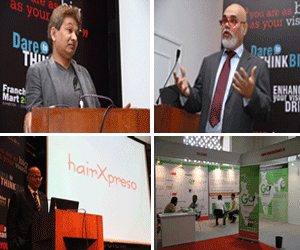We are perennially confused about which path to choose while banking on a sector. Although the ideal proportions with geometric descriptions can’t be given about the path to be treaded, here we have tried to put the five strong performing sectors on which one can bank on to become the Vitruvian business personality…
Beauty & Wellness
There is a general consensus in the business world that the wellness industry is the up and coming market of today. Increasing health awareness among Indian consumers due to rising media penetration is also helping the sector to grow.
According to GS Kochar, VLCC’s head franchise development and operations, the year 2012 has been very exciting for the sector. For the past couple of years, the sector has been growing really well. Talking about the performance of the sector, he says, 25-30 percent growth per year is definite.
In his “highly satisfactory” 12 year journey with the company, he has witnessed an enormous growth of the company.
The year 2012 has been good for the company as it is, “expanding internationally, and the company has grown not only in India but also overseas. We recently acquired a Malaysia based company and now planning to enter Egypt and Saudi Arabia.”
The company is increasing the number of its franchise-owned outlets as well as company-based outlets. As the company wants to grow organically and geographically, the biggest challenge is finding the right franchise partner to deliver customer satisfaction. Another challenge is to reach the tier II, tier III, tier IV cities as far as the growth is concerned.
According to him the demand for health and wellness services are increasing as people are getting more conscious of their personality, grooming and fitness level. “People are getting attracted to the health and wellness sector as we are becoming globalised, disposable incomes are rising, and education level and travel are on the increase,” says Kochar. Spurred by the heavy demand to look good, VLCC is today a leader in the industry, with over 160 outlets in the country. “Every month we witness improved sales growth. This sector will keep growing for the next decade,” says Kochar.
The company has got a number of projects in the pipeline which will be operational from March 2013. Kochar sees a huge potential in this sector in the year 2013. “This sector is growing by leaps and bounds, every month selling more and more number of franchises,” says Kochar.
According to him a lot of entrepreneurs want to get into this industry. People from other industries are finding growth difficult in their own industries and want to jump shift to this industry. A lot of NRI’s want to come back looking for a good business for themselves in this industry, for this is the business which is recession proof and will give them good return on investment.
With the general knowledge that women are increasingly joining the workforce and hence indirectly contributing to the increasing urban population, this translates to more income and higher purchasing power for women today. This means that the wellness market, which is generally still women centric, has grown and will continue to grow tremendously.
Another target market that is slowly emerging is the traditional market of male consumers. This hugely untapped market is becoming more aware of their looks and need to have basic hair and skin care as the environment and pollution will ultimately affect them too.
This essentially means hair care and beauty today is no longer a luxury item but a basic necessity for many people.
This is especially true when the economies have been experiencing growth and the affluence of the people keeps rising.
Hair styling and beauty is also becoming important not only in terms of looks but also as a tool for self confidence. The young generation, who are now entering the workforce and have reasonable disposable income are becoming more knowledgeable and educated and hence more aware of product efficacy, although price still play a major role.
Education
Education in India is gliding towards new hopes with the policy of government i.e. Right to Education Act (RTE) providing a strong backbone. The move has seen a flow in enrolment at the primary education and middle level. Consequently, it is making a strong case for higher education in the long term. Apart from that, there is surely a growing trend among youth for professional courses which has encouraged many private firms to bring up private institutes offering the same, with enhanced excellence.
With 7.2 million Indian children out of school, 20 million child laborers and less than 3.3 percent of the country’s gross national product spend on education, education in the country is in disarray. Moreover, UNESCO’s 2007 survey in India claims that only 58 percent children in Grade-3 in government schools can subtract or divide.
Sadly, some may argue, imparting education is a business in the country. The flip side being, commercial as it may be it has armed millions of Indians with skill sets to succeed in life.
The mushrooming of learning solution centers for MBA, engineering, computer education and English language speaking, is filling up the void created by system, which has not been able to afford quality education for all.
What makes it trendy among investors?
According to the Ernst & Young report, India is a desirable destination for education industry as it figures at the top of the most-sought after markets in the world, in which majority of population consists of the people aging from 15 to 24 years.
The industry is also seen as relatively recession-proof industry during the time when the large sectors in India was under the grip of inflation, as education is an essential requirement for a successful career. Going with the official findings, Indian consumers spend nearly 10 percent of their household budget on education, and close to a third of every child attend extra classes outside school hours. According to Amitabh Lahiri, Head of NIIT, Asia’s largest IT Training, the growth and challenges which India is currently facing in education sector is tremendous.
“When it comes to the company, overall, the year went smooth for NIIT, as it has improved its IT education market share from 50 per cent to 54 per cent, despite a challenging environment.”
NIIT ventured into the franchisee business model in early 1980s. The Franchisee network run by its business partners, not only helped NIIT expand its presence across India and reach the un-reached, it also fueled the fire of entrepreneurship in the country. NIIT helped young Indians, with ambitions to set up profitable businesses and participate in the growth of the exciting IT industry.”
For franchisees in the category, the benefits come from the specialized and proven curriculum and courseware that makes it a preferred choice of individuals and enterprises.
Lahiri explains that the company has been able to successfully ward off the challenges that prevail in the market by devising some strategies. He explained that in a challenging market, NIIT’s strategic decision to focus on the four platforms of growth — Cloud Campus, Managed Training Services, Nguru & NIIT Yuva Jyoti — continued to drive business momentum for the company. “NIIT’s pioneering Cloud enabled ‘New-age GNIIT — India’s First Cloud Campus’; and partnership with NSDC to form NIIT Yuva Jyoti Ltd, which aims to provide industry and job specific training to around 70 lakh young Indians by 2022, have added momentum to NIIT’s thrust on innovation,” says Lahiri.
Growth perspective for 2013
The education sector in India has a lot of potential, and the results are assumed to be quite productive. As the study suggests, private education sector in India is estimated to reach about Rs. 3,800 crore ($70 billion) by the year 2013.
The solid collaboration of corporate and academics and the building of brand are some initiatives which are needed to lead education industry in India towards healthier future.
Travel & Tourism
According to the Ministry of Tourism, Government of India, for the year 2010 outbound tourist was in the range of 1.2 crore at a growth rate of 17.4 percent. Inbound tourism was pegged at 57.8 lakh heads at a growth of 11.8 percent.
Domestic Tourism accounted for 74 million tourists at a growth rate of 10.7 percent. Despite a slowing economy and turbulent global economic scenarios, tourism within the country has shown little signs of slowing down.
For many tour, travel operators and travel e-commerce sites, franchising route is the fastest way to expand, ensure market penetration and business growth with minimum investment. Since franchisees are generally owned by local entrepreneurs, they have an in-depth understanding of consumer behaviour and other dynamics in their respective markets that, in turn, is beneficial to mutual growth.
Franchising will also allow the travel company to grow without sacrificing control over the business. Most opting for franchise retain control over how franchisees operate the business and ensure compliance to the operating system in the best interests of both parties. The success of one location spills over to the rest of the franchise network.
Why buying into a franchise makes sense:
Being in the franchising business has many advantages.
Some key benefits are:
Business is based on a proven format leading to minimal risk
Advantage of using a recognized brand name and trademarks
Lead generation benefits from advertising or promotions done by the franchisor
Franchisor Support — including Training &Business Setup
Implement tried and tested Standard Operating Procedures
Benefit from communicating and sharing ideas with, and receiving support from, other franchisees in the network
Take advantage of established supplier relationships
Encash on the domain expertise and experience of the franchisor’s management teams
Reduced transaction costs and service turnaround times.
Ability to be positioned as a one-stop-travel-shop for all travel needs.
Best-in-class technology to facilitate and manage online transactions
Requirements:
Franchisors generally look for committed and passionate partners who, together with the company, can carry forward the mission of making a wide range of travel services available, under one roof, to customers at affordable prices, backed by exemplary customer service, at all times. For most, the preferred owner should be a graduate with a good track record in the market, effective social network to solicit business, proven entrepreneurial skills, sound financial background and capability and willingness to invest. In terms of capital required, around Rs. 5-10 lakh would be ideal depending on the city. In terms of area of the franchise, 200-400 sq. ft. would be apt. For the franchisee the RoI period is generally between 12-18 months.
According to PhocusWright, the Indian travel market grew 14 percent in 2011 and is poised to continue growing in double-digits through 2013 to $24.6 billion. OTAs grew faster than the industry —their gross bookings grew at more than three times the rate of the industry, climbing to $2.1 billion in 2011. It is expected to reach $3.4 billion by 2013.
Valued at over Rs 50,000 crore, tourism is the largest service industry in India, with a contribution of 6.23 percent to the national GDP and 8.78% of the total employment in India. More than 8 million Indians enjoyed their holidays abroad and over 560million Indians enjoyed their holidays within India last year. Additionally, the country witnessed arrival of over 5 million foreign tourists over the past year. According to World Travel and Tourism Council, India will be a global tourism hotspot from 2012 — 2018. Foreign tourists spend more in India than in almost any other country worldwide and tourist arrivals are projected to increase by over 22 percent each year. With domestic tourism also growing by the day, the tourism industry will continue to boom and see meteoric growth rates over the next decade. It is one of the most exciting industries to be in, as corporate and as a budding entrepreneur.
Specialty Restaurants, coffee shops
The demographic rise in younger population and the working class in India are expected to provide a great impetus to the restaurant business. KSA Technopak’s 2009 survey revealed that in India, people aged 21-40 years eat out regularly.
As per the National Commission on Population (NCP), nearly 68 percent of the 1.1 billion population in 2006 are below the age of 35 years (with a median age of 24 years). “Besides, with the expected strong long-term GDP growth rate in India likely to create more employment opportunities, one can expect to see an increase in the present base of working population,” says research firm Crisil. The agency also goes on to quote that as per the Central Statistical Organisation, the proportion of working age population (comprising 15-59 years) in India will rise to 62 percent by 2016 from 59 percent in 2006. Also, increasing urbanisation, a growing middle class population and rising disposable income in India are leading to an increase in dining out as a lifestyle choice. Rapid transformation in the lifestyle of Indians, particularly those living in urban areas, has resulted in dramatic increase in the demand for fast food.
Speciality Restaurants Ltd, one of the leading fine-dining restaurant operators in India, which runs brands like Mainland China, Oh! Calcutta, Machaan, Sigree, Flame & Grill and Haka have seen strong growth. The company also operates a confectionery brand, Sweet Bengal, in Mumbai.
From the first restaurant in 1992 under the name Only Fish at Mahim, Mumbai, which was renamed Oh! Calcutta in 1996, as of December 31, 2010, the company operates 62 restaurants and 11 confectionaries under 11 brands in 17 Indian cities and one in Dhaka, Bangladesh.
Of the 62 restaurants, 17 are under the franchise owned and company operated (FOCO) model and the rest is owned and operated by the company (COCO). The company, with this strong growth in mind went for an IPO in May this year with the issue getting over-subscribed by 2.54 times, thus helping the company raise around Rs. 175 crore at an issue price of Rs 150 per share.
On the other hand “although specialist coffee chains’ contribution to India’s total coffee consumption by volume may not be significant, these coffee shops have added more visibility to the coffee culture,” says Rabobank International.
The first specialist coffee shop by Café Coffee Day opened up in 1996 and the company has since grown to a market leading position with 1,350 coffee shops spread across India. At present, there are around 2,100 specialist coffee shops in India, and given that there are multiple international coffee shop chains trying to expand their base in this important market, consumers are likely to have even more options within the next three years.
According to a new report, coffee chains are also offering a new snacking/leisure experience.
These coffee chains offer an experience similar to that in the developed markets.
The opportunities for coffee chain growth arise from the favourable demographics with low per capita consumption and increasing income levels, the rise of mid-sized cities and a high population density with its associated potential for the expansion of the coffee shop network.
“The impressive growth expected of specialist coffee chains in India offers numerous opportunities for both local and international players, provided that they can overcome inherent obstacles” says Nitin Kalani, Beverage Analyst at Rabobank International, author of the report.
This also means windfall opportunities for franchisees.
Retail
The current estimated value of the Indian retail sector is about $500 billion and is pegged to reach $1.3 trillion by 2020. According to a FICCI-PwC report, the penetration level of modern retail (currently 5 percent) will increase six-fold from the current $27 billion to $220 billion by 2020. The Indian retail sector is expected to grow at a CAGR of 15 to 20 percent. According to the report, factors driving the organised retail sector include the following:
Higher incomes driving the purchase of essential and nonessential products
Evolving consumption patterns of Indian customers
New technology and lifestyle trends creating replacement demand
Increase in rural income as well as urbanisation
Increase in easy access to credit and consumer awareness
Growth of modern trade format across urban, Tier I, Tier II and Tier III cities and towns
Rapid urbanisation and growing trend towards nuclear families.
The growth of the retail industry is expected to add jobs in both the organized and traditional segments as overall consumption are seen growing.
While modern retail is expected to add 2.7 million jobs in the coming decade, traditional retail is seen creating nine million more in the coming decade, said a Technopak report.
The Indian retail sector accounts for over 20 percent of the country’s gross domestic product (GDP) and contributes eight percent to total employment.
The cumulative foreign direct investment (FDI) inflows in single-brand retail trading, during April 2000 to June 2011, stood at $69.26 million.
Despite a sluggish economy, retail is one sector which will continue to go.
Modern retail gets lucrative when certain scale is reached and as more and more companies enter the lucrative segment, the push to grow and be profitable would be evident.
As companies look to spread to smaller towns, many retailers would prefer to opt for the franchising route, rather than opting for a cumbersome company operated store.































 +91 9909960054
+91 9909960054